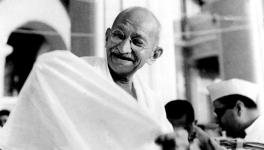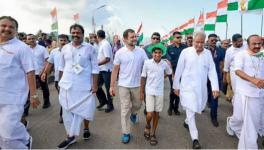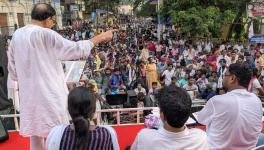Corona Jihad and Media’s Communal Polarisation
India may be able to neutralise the deadly Covid-19 but it has lost its fight against communal polarisation. The division between the Hindu majority and Muslim minority has manifested as never before. Social media is filled with hate messages. India seems to be at war with its own people.
They say the first casualty in any war is the “truth”. The Tablighi Jamaat (TJ), a Sunni sect with followers all over the world, has been accused of being the main carrier of Covid-19 in India.
“Corona Jihad” has become a political issue; its communalisation started when the news “broke” in some mainstream channels and social media that the infected people of TJ were hiding at its headquarters (or markaz) in Basti Nizamuddin in Delhi. This happened late in the evening on 30 March, but the real story started much earlier, at Patna in Bihar. Bihar is to hold its Assembly elections by October this year.
On 3 March, video stories from some news channels started circulating, mainly on WhatsApp groups, which said that Coronavirus-infected people were hiding in a mosque at the Kurji neighbourhood of Patna, the capital of Bihar. The footage showed some foreign nationals with Mongoloid features being taken away by the police from a mosque while a crowd heaped slurs on them. It was alleged that these were Chinese Muslims, or from Iran or Italy, who have come to India to spread Covid-19. Some same there were 40-50 such people, and they have been arrested.
Viewers added their responses to these videos, and the matter slowly took the shape of a conspiracy against India. The way the videos went viral made it clear that the “idea” had the full potential to spark nationwide outrage. India had just started its fight against Covid-19 at the time, against the backdrop of large number of worldwide deaths.
A fact-check later revealed that 12 people had been arrested, of whom 10 were from Kyrgyzstan, not Italy or Iran. All of them had tested negative for Covid-19 at AIIMS, Patna. Two batches of TJ were held in Bihar, one in Patna and the other at Buxar. All of the attendees from overseas were found to have had valid tourist visas. The TJ holds its events at specific mosques (usually from Friday to Sunday) where its members preach about Islam among Muslims.
The government of India is well aware of the activities of this 100-year-old organisation, which holds large and small congregations all over India. They are considered peaceful and apolitical without any history of illegal, violent or unlawful activity. There are two key academic studies on them, by Yoginder Sikand in 2002 and Farish Noor in 2003, which is on their operations in South East Asia. However, political opportunists, at the first given chance, gave this congregation a motivated and malicious bent.
Walter Lippmann, media theorist who studied stereotyping in his book Public Opinion (1922), says that people respond to issues “depending on their cognitive factor or mental constructs”. For the 17th-Century plague in Britain, people blamed the Scots, the Catholic sorcerers, the Independent Congregation Church. In the 20th Century, Jews were stereotyped as the ones responsible for the world’s ills and framed as “international conspirators”. Writers such as Shmuel Ettinger, Salo Baron, Lucy Dawidowicz and Bruno Bettelheim have written about how these stereotypes were deployed to put the chilling Holocaust into action.
Nearly 26 days after the Patna incident, news “broke” again, now in Delhi, that Covid-19 infected people were “hiding” in the TJ headquarters (Markaz). It was alleged most members of the TJ are foreigners and that they are refusing health check-ups; also that the are being rude and aggressive with the police.
In Patna and Delhi, the term “hiding” was used by the media to describe the behaviour of TJ members. Scared of the media attack, a few of them met a lawyer in Delhi after which they released a press statement stating their version of events and facts. They disclosed that the TJ was trying to evacuate people ever since the ‘Janta Curfew’ was observed on 22 March, abiding by the Prime Minister’s announcement.
TJ’s administration, the statement said, was in touch with the local police station, a stone’s throw from the Jamaat Markaz (masjid) since 24 March, had visited the local authorities twice and asked for curfew passes for 17 vehicles. Permission was not given. Health officials visited the Markaz several times and took away the sick people and got them admitted in hospital.
After a week, news “broke” again about their alleged “resistance” and about infected people “hiding in the mosque”. TJ clarified it was necessary, to restrict the spread of the disease, for all such people to be kept within the mosque and not allowed outdoors. It was impossible to ferry people to different destinations due to the complete lockdown.
Also, Delhi Police was quick to forcibly dismantle the anti-CAA Shaheen Bagh protest on 25 March, which had just five women protesters left, it did nothing to relocate about the 1,000 stuck at the Markaz until 30 March.
However, even TJ insiders feel that they should have acted as early as in the first week of March. But then, who else was serious till the Janta Curfew was announced? Parliament functioned normally till a politician suspected to be a Covid-19 carrier first visited Parliament and then quarantined himself. The Supreme Court, high courts, several temples, gurdwaras and mosques functioned normally despite the Delhi government’s directive/advisory against these. Some 200 people were evacuated from the Majnu Ka Tila Gurudwara in Delhi just a day after the TJ fiasco. The TJ is part of the very same society as all these other organisations.
The “resistance of Jamaat” theory was further enhanced the next day when a video of a man spitting on a policemen went viral. It was claimed that he is one of the infected TJ men, trying to spread Coronavirus in India. Here was “proof” of the “Corona Jihad” conspiracy. This video did the rest of the work. A journalist circulated a WhatsApp message, in the form of news, urging people to thrash TJ people half-dead, for any assault on them would be “self-defense”.
A Muslim family living in a Hindu majority neighbourhood made a distress call to someone I know, saying that people are saying on the street outside her home that Muslims should be thrown out through the NRC (National Register of Citizenship) for spreading Covid-19. On 3 April, unverified news came of about 200 people descending upon a mosque in North West Delhi during the lockdown. There are viral videos doing the rounds urging people not to allow Muslim vendors in their locality. A radio jockey has shared a video in which residents discuss not allowing Muslims to enter their locality, Shastri Nagar.
A fact check of the “spitting video” later revealed that it was from 29 February and of an under-trial prisoner in Mumbai who spat on a policemen for not being allowed home-cooked food. This was reported in the newspapers on that day. Such unruly behaviour is common among prisoners. Then two more such spitting videos linked to “Corona Jihad” started circulating. One is apparently about a year old and is of a restaurant in Singapore or Dubai; the veracity has not yet been established. The other is a 40-second clip of a fruit-seller from Madhya Pradesh. Most media stories played it in juxtaposition to the Delhi Markaz and called it “Corona crime”. A man in this video is ‘polishing’ fruit with saliva. To protect themselves from liability, the mainstream media used a police byte in the video which declares it an old clip of a mentally-challenged man. However, the essence of the story had the anti-Muslim narrative and it was carried on social media filled with hateful anti-Muslim commentary. Numerous video messages on social media are ridiculing Muslims as “uncultured” and, of course, “anti-national”.
Hysteria defies reasoning. As Lippmann’s famous theory of “picture in our heads” says, we don’t see things and analyse. We first analyse things and then see. In other words, we see facts influenced by our cultural indoctrination, which takes place over time. A Hindu acquaintance wrote on her Facebook page that she earlier did not believe when she was told that Muslims spat on food they offered to Hindus. After seeing the fruit-sellers video and commentary she believes they do; even after being told that it was a fake: a stereotype, once lodged, becomes difficult to remove.
Another video from Indore in Madhya Pradesh showed a group of Muslims throwing stones at health workers. It was used to send the message that all Muslims are assaulting health workers. A fact-check has revealed that people had initially agreed to health checks, but influenced by fake messages that health workers will infect Muslims, they attacked the workers. The uneasy relationship of Muslims with the government over the last few years has contributed to this situation, but this context is never provided by the media.
On 1 April, there were newspaper reports of mobs attacking policemen trying to enforce a lockdown in Muzaffarnagar in Uttar Pradesh, including visuals of cops soaked in blood. That did not attract as much attention as the videos featuring Muslims.
The final assault came in the form of a letter from the Chief Medical Officer (CMO) purportedly written to the police and leaked to the media which has made its way to social media. The letter says that some nurses have complained of “Jamaati patients” running around half-naked and behaving indecently with nurses. The letter arouses suspicion for it is unusual for a doctor to categorise patients as “Jamaati patients”. The letter itself was meant to be confidential but still got leaked to the media almost as soon as it was written. Also, there is no video “proof” of the events, when normally that does happen. However, a case has been registered and investigations are on, which one has to await.
It cannot be ruled out that some people might be trying to escape a health check-up. But this is primarily due to fear of the police. Many believe that they be jailed if found Covid-19 positive—and this is not just true of Muslims. Some 22% people in Delhi have recently told NetaApp, during an app-based poll, that they would not report to the health authorities if they experienced symptoms of Covid-19. When a disease is stigmatised and criminalised, it is natural for people to attempt escape from testing and hospitalisation. Fact is, many reports of allegedly unruly behaviour of TJ members have turned out to be fake, including one from Saharanpur, which the local police itself classified a rumour.
As any doctor knows, it is quite common for patients to get unruly. Patient behaviour is not specific to religion. For example, on 12 March, newspapers reported that the Army faced a new problem at an isolation centre in Manesar. People who had been brought there from Italy via an Air India flight, had demanded separate rooms for families and were abusive to health workers. Some also broke quarantine.
Having seen the TJ from close quarters for more than two decades, and ridiculed them for being an apolitical and a worthless puritanical organisation, it is hard to believe that its members acted “indecently”. At Aligarh Muslim University, many contemptuously refer to them as ARPF or Allah Rasool Police Force and often run away from their unending sermons on religion.
Yet the Jamaat episode has served two purposes: It stereotyped Muslims as uncultured and anti-national and took attention away from the real problems of Covid-19, such as the lakhs of migrant workers who left for their villages after the lockdown. On 31 March, Solicitor General Tushar Mehta told the Supreme Court that every three in ten workers may carry the infection to villages. Nearly 6.6 lakh workers have possibly migrated already. The shoddy quarantine facilities for them has also escaped media scrutiny.
The United Nurses Association (UNA), an association of nearly 3.8 lakh nurses, has approached the Supreme Court seeking basic protective kits and other facilities to work on Covid-19 patients. Their petition says that the government has no action plan or preparedness to deal with the crisis, leaving doctors and nurses at great risk of infection. Several doctors and nurses at a government hospital in Delhi have resigned due to lack of resources. But the media has sadly remained a propaganda machine spreading hate.
Several religious groups have spread Covid-19 in the world by now, primarily because they are closed communities. ISKON was a main carrier of the virus in London. Does this mean we can spread hate against this sect? In Bhilwara, Rajasthan, a doctor couple spread the virus to 27 people after returning from a trip abroad. Does this mean all doctors are to blame? In fact the Bhilwara model, which helped restrict the disease to the district, may be replicated elsewhere.
No doubt the organisers of the TJ in Delhi should be held responsible for ignoring warnings and calling the disease a “conspiracy against Muslims”, but it must not be used to stereotype all of India’s 150 million Muslims, to isolate them and surround them with fear and uncertainty.
The author teaches history at Aligarh Muslim University. The views are personal.
Get the latest reports & analysis with people's perspective on Protests, movements & deep analytical videos, discussions of the current affairs in your Telegram app. Subscribe to NewsClick's Telegram channel & get Real-Time updates on stories, as they get published on our website.
























